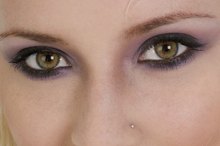What does fact checked mean?
At Healthfully, we strive to deliver objective content that is accurate and up-to-date. Our team periodically reviews articles in order to ensure content quality. The sources cited below consist of evidence from peer-reviewed journals, prominent medical organizations, academic associations, and government data.
- The National Center for Biotechnology Information: "Use of Eye Movement Auditory Biofeedback in the Control of Nystagmus
- The National Center for Biotechnology Information: "Use of Eye Movement Auditory Biofeedback in the Control of Nystagmus
The information contained on this site is for informational purposes only, and should not be used as a substitute for the advice of a professional health care provider. Please check with the appropriate physician regarding health questions and concerns. Although we strive to deliver accurate and up-to-date information, no guarantee to that effect is made.
Eye Exercises for People With Nystagmus
Can specific eye exercises improve vision for people with nystagmus? Among medical professionals, the answer is debatable. The American Academy of Ophthalmology reports that eye exercises rarely help control nystagmus 1. Yet others in the field suggest certain eye exercises may provide some relief from the eye movement disorder. Most agree that doctor-supervised Vision Therapy or a combination of exercises along with Auditory Biofeedback Training reduces symptoms of nystagmus.
If you are experiencing serious medical symptoms, seek emergency treatment immediately.
Nystagmus
Nystagmus is a visual impairment that causes the eyes to make repetitive, uncontrolled movements from side-to-side, up and down, or in circles. Most often, nystagmus is involuntary and reduces or limits vision because rhythmic shaking or jerking of the eyes makes it difficult to focus. Of the more than 45 distinct types of nystagmus, the two most common are congenital (early onset nystagmus) and acquired (developed later in childhood or as an adult). Contact lenses, eyeglasses with prisms, eye muscle surgery, Auditory Biofeedback and Vision Therapy are used in treating nystagmus. Eye exercises listed in the following steps may also reduce symptoms of the disorder.
- Nystagmus is a visual impairment that causes the eyes to make repetitive, uncontrolled movements from side-to-side, up and down, or in circles.
- Most often, nystagmus is involuntary and reduces or limits vision because rhythmic shaking or jerking of the eyes makes it difficult to focus.
Focusing Exercise
What Are the Causes of Involuntary Eye Movement?
Learn More
Any small, hand-held object, such as a pen, can be used to practice focusing. Hold the object at arm’s length and focus on a tiny area such as the point of a pen. Gradually, move the pen toward the tip of your nose until it starts to appear as a double image. Draw the pen slightly away from your nose until a single image appears. Focus on the targeted area of the single image for 10 seconds and repeat 10 times, two to four times a day. Continue sessions of the exercise daily until ability to hold focus on the tip of your nose is achieved. Taper off exercises and use as-needed when symptoms recur.
- Any small, hand-held object, such as a pen, can be used to practice focusing.
- Draw the pen slightly away from your nose until a single image appears.
Eye Positioning Exercise
Positioning the eyes to look to one side while maintaining a specific head posture improves control of eye movements and vision. When someone with nystagmus looks in an odd direction, a “null point” is found where symptoms are reduced. Practicing certain head postures and eye directions may improve vision and reduce the intensity of nystagmus symptoms.
Clarity/Range Exercise
Facial Exercises for Stroke Patients
Learn More
Distant objects appear unfocused and unclear to those suffering from nystagmus. They can attain clarity and focus by moving closer to objects. Practice moving closer to objects until you can see them clearly. Note the specific range at which you are best able to see objects and practice moving into that range.
- Distant objects appear unfocused and unclear to those suffering from nystagmus.
- Note the specific range at which you are best able to see objects and practice moving into that range.
Vision Therapy
Vision Therapy enhances the brain’s ability to control eye movements, focus, tracking, alignment and visual processing. Individualized to meet a patient’s needs, the doctor-supervised therapy is a progressive program of eye exercises and procedures. Therapy, administered during office visits over several weeks, may include:
- the use of prisms
- lenses
- filters
- computers
- other optical devices
You should practice any techniques learned in therapy at home. Vision Therapy is costly, however, and your insurance may not cover it. Kenneth Ciuffreda, O.D., Ph. D, SUNY/ State College of Optometry and others report successful multimodal treatment of nystagmus. This information is found in the case study of a teenager denied a driver’s license due to visual impairment. Four months of conventional Vision Therapy, prisms, and corrective lenses improved visual acuity and reduced the teen’s nystagmus from “large and constant” to “small and intermittent…” The teen's improved vision enabled him to obtain a driver’s license, and his nystagmus eventually became undetectable.
- Vision Therapy enhances the brain’s ability to control eye movements, focus, tracking, alignment and visual processing.
- Four months of conventional Vision Therapy, prisms, and corrective lenses improved visual acuity and reduced the teen’s nystagmus from “large and constant” to “small and intermittent…” The teen's improved vision enabled him to obtain a driver’s license, and his nystagmus eventually became undetectable.
Auditory Biofeedback
The Journal of Behavioral Optometry reports positive results with congenital nystagmus patients following Auditory Biofeedback training. In addition to reducing nystagmus and improving vision, biofeedback training can lead to positive cosmetic and psychological changes in patients. According to The National Center for Biotechnology Information, eye movement Auditory Biofeedback reduced nystagmus in five adult patients within the first hour of training 4. During the training, patients improved their vision and learned how to reduce nystagmus upon command with conscious effort.
- The Journal of Behavioral Optometry reports positive results with congenital nystagmus patients following Auditory Biofeedback training.
- According to The National Center for Biotechnology Information, eye movement Auditory Biofeedback reduced nystagmus in five adult patients within the first hour of training 4.
Causes
Nystagmus is caused by abnormal brain functioning in areas that control eye movement 4. According to the American Academy of Ophthalmology, nystagmus occurs in albinos, severely near or farsighted persons, or those with congenital cataracts, inner ear inflammation, astigmatism or scars in the optic nerve or retina 1. Other causes of nystagmus include medications, metabolic disorders, central nervous system diseases and alcohol or drug toxicity. Infrequently, the condition results from severe neurologic disorders or brain tumors. It is important for persons with nystagmus to have a thorough eye examination by an ophthalmologist to determine the cause and best course of treatment.
- Nystagmus is caused by abnormal brain functioning in areas that control eye movement 4.
Related Articles
References
- American Nystagmus Network: “Eye Facts About Nystagmus,” reprinted from American Academy of Ophthalmology, July 3, 1999
- Women Fitness, Nystagmus
- American Optometric Association: Nystagmus, 2010
- The National Center for Biotechnology Information: "Use of Eye Movement Auditory Biofeedback in the Control of Nystagmus
- Eggers SDZ. Approach to the examination and classification of nystagmus. J Neurol Phys Ther. 2019;43 Suppl 2 Supplement, Special Supplement: International Conference on Vestibular Rehabilitation:S20-S26. doi:10.1097/NPT.0000000000000270
- Kang S, Shaikh AG. Acquired pendular nystagmus. J Neurol Sci. 2017;375:8-17. doi:10.1016/j.jns.2017.01.033
- Serra A, Chisari CG, Matta M. Eye movement abnormalities in multiple sclerosis: Pathogenesis, modeling, and treatment. Front Neurol. 2018;9:31. doi:10.3389/fneur.2018.00031
- Kruijt CC, De wit GC, Bergen AA, Florijn RJ, Schalij-delfos NE, Van genderen MM. The phenotypic spectrum of albinism. Ophthalmology. 2018;125(12):1953-1960. doi:10.1016/j.ophtha.2018.08.003
Writer Bio
Cheryl A. Beller has worked as a journalist in Michigan since 1976. Her articles and newspaper columns have appeared in "The Grand Rapids Press," "The Daily Tribune," "Advance Newspapers," and numerous other publications. She has won awards from United Press International and the Michigan Press Association. Beller holds a Bachelor of General Studies degree with majors in journalism and English from the University of Michigan.









